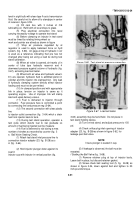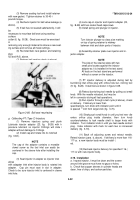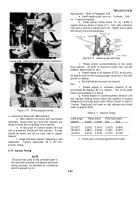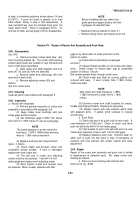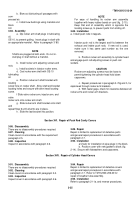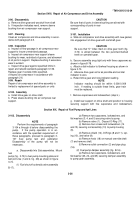TM-9-2815-213-34 - Page 70 of 192
*TM 9-2815-213-34
nector (fig. 3-83), to 1/4-inch flare connector on pump
inlet adapter assembly.
NOTE
If during operation of the stand oil is sucked
into vacuum gage no. 1 (fig. 3-80) it will be
necessary to use a supplementary vacuum
gage (vacuum gage no. 2, fig. 3-80).
Disconnect hose from stand supercharger inlet
connector (fig. 3-83) to pump inlet adapter.
Connect flexible hose from supplementary
vacuum gage no. 2 to pump inlet adapter (5,
fig. 3-79).
(9) Install pump discharge fitting assembly (4, fig. 3-79)
in pump fuel shutoff solenoid valve (fig. 3-83).
(10)Install flexible hose (10, fig. 3-79) from stand
"PRESSURE GAGE" outlet to pump discharge fitting (fig.
383).
(11)Install flexible hose (9, fig. 3-79) from stand
"FUEL INPUT" connection to pump discharge fitting (fig.
3-83)
(12)Install /2-inch ID flexible hose (8, fig. 379) from
stand "FUEL OUTLET" connector to stand "FUEL
RETURN" connector (fig. 3-83).
(13)Install flexible hose (6, fig. 3-79) to no. 1
accumulator can (fig. 338), from stand "LEAK TEST"
connector.
(14)Turn on fuel heat switch (fig. 3-80), observe that
temperature on "FUEL TEMPERATURE" gage is
between 80 to 100 degrees for testing.
d.
Gear Pump Test
.
CAUTION
Never operate fuel pump until check valve has
been checked for restrictions.
(1) Set stand motor switch (fig. 3-80) to "FORWARD."
This corresponds to code designation on pump name
plate. "L" for left-hand (fig. 3-84), as viewed from rear of
pump.
(2) Open stand "BYPASS VALVE," "SUCTION
VALVE" and "FLOW CONTROL VALVE." Back seat all
other valves to prevent leakage (fig. 3-80).
(3) Open pump solenoid manual overide knob (fig.
3-73) by turning fully clockwise.
(4) Install throttle spring (fig. 3-82) to hold throttle in
wide open position.
(5) Set stand 4-way valve to "ROTAMETER"
position (fig. 3-80).
(6) Set stand power switch to "ON" position.
(7) Turn range crank to "LOW RANGE" (fig. 3-80).
(8) Start stand and pump operation by depressing
start switch. Depress and release switch until pump
operation is between 400-450 rpm as observed on stand
"TACHOMETER" (fig. 3-80).
NOTE
Check rotameter for presence of air in fuel
flow. If air bubbles are present, work pump
throttle from full open to idle, several times, to
relieve any entrapped air in pump.
(9) Turn on "AUX MOTOR" switch for one minute, to
eliminate any air entrapped in test stand (fig. 3-80).
(10)Adjust "FUEL REGULATOR" to a maximum of
20 psi as observed on "FUEL PRESSURE" gage (fig. 3-
80).
(11)Shut-off "AUX MOTOR" switch.
NOTE
If air bubbling persists check all lines for
leakage. If no leaks are uncovered, or, if fuel
pump fails to pick-up fluid the pump must be
disassembled and repaired or replaced.
Proceed with the following steps only if pump
is operating satisfactorily.
(12)Increase pump speed to 2100 rpm.
(13)Set pump throttle to wide open position.
(14)Set "SUCTION
VALVE,"
"BYPASS VALVE" and
"FLOW CONTROL" to fully open position.
NOTE
Indicated flow on the rotameter should be not
less than 850 pounds per hour (pph).
e.
Inspection of Sub-Assemblies
.
(1)
Fuel Shut-Off Solenoid Valve Assembly
.
(a)
Visually inspect shut-off valve and valve seat for
wear and corrosion. Valve seat must be 0.015 inch
minimum width.
(b)
Check oil assembly with ohm-meter. Replace
coil if resistance is below 30 +3 ohms.
(2)
Fuel Pump Damper Assembly
. Inspect body,
plate, and diaphragm for excessive wear.
(3)
Mainshaft Cover and Governor Assembly
.
(a)
Perform general inspection in accordance with
paragraph 2-6.
(b)
Place one leg of depth gage base of pedestal
across the carrier walls and measure down to the front
cover gasket surface (no
3-41
Back to Top

